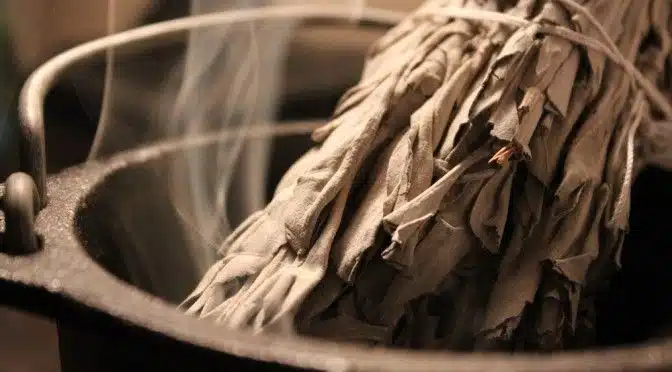Smudging is a practice that has been used for centuries in many cultures around the world, especially by indigenous peoples in North America.

It involves burning sage and other herbs to purify the air, cleanse spaces, and remove negative energy. While it has long been considered a spiritual or ritualistic practice, modern science is beginning to uncover the tangible benefits of smudging when it comes to cleaning the air of harmful bacteria and other microbes.
But is there any scientific evidence to back up these ancient claims? In this article, we’ll explore the fascinating science behind smudging and find out exactly what sage does to bacteria in the air.
What is Smudging?
Smudging is the ritualistic burning of sage (usually white sage) and other herbs like cedar, sweetgrass, or lavender.
This practice is typically performed using a bundle of dried sage leaves, called a smudge stick, which is lit and allowed to produce smoke.
The smoke is then gently wafted through the air using a feather or hand, while intentions of cleansing or healing are set.
The aromatic smoke produced by burning sage has long been believed to have purifying properties, and practitioners of smudging often use it to cleanse homes, objects, or even people.
But beyond the spiritual and psychological benefits, does burning sage have any measurable impact on the physical environment?
The Science of Smudging: What Sage Does to Bacteria
Recent research suggests that there may indeed be scientific evidence to support the idea that smudging can help purify the air.
One study, published in the Journal of Ethnopharmacology in 2007, examined the effects of burning medicinal herbs, including sage, on airborne bacteria.
The Study: Air Purification with Medicinal Herbs
The research study, led by Dr. Narendra Singh and his team, investigated the antimicrobial potential of burning traditional medicinal herbs. The researchers wanted to determine whether the smoke from these herbs, including sage, could actually reduce the number of airborne bacteria and other pathogens.
Key Findings:
The study found that burning medicinal herbs like sage significantly reduced the number of airborne bacteria. In fact, the smoke from the herbs eliminated up to 94% of airborne bacteria in a closed space within just one hour.
What’s even more impressive is that the air remained almost completely free of harmful bacteria for up to 24 hours after smudging. Some potentially pathogenic bacteria were absent even after 30 days in the smudged environment.
These findings suggest that the antimicrobial properties of burning sage could indeed help reduce the presence of bacteria and other microbes in the air, making it a viable option for air purification in enclosed spaces.
How Does Smudging Work?
The antimicrobial effects of sage smoke are believed to come from the bioactive compounds found in the plant, including volatile oils and terpenes like 1,8-cineole (eucalyptol), camphor, and thujone.
When burned, these compounds are released into the air and may interact with the cellular structures of bacteria, effectively neutralizing them.
Here’s a closer look at how some of these compounds work:
1,8-Cineole (Eucalyptol): Known for its antibacterial and anti-inflammatory properties, 1,8-cineole has been shown to inhibit the growth of certain bacteria and fungi.
Camphor: This compound has strong antimicrobial and antiviral properties, which may help eliminate harmful pathogens from the air.
Thujone: A major component of white sage, thujone has both antimicrobial and insecticidal properties, making it effective against a range of bacteria and pests.
The interaction of these compounds with bacteria in the air likely contributes to the purifying effects of smudging.
Other Benefits of Smudging
Beyond its impact on bacteria, smudging with sage may offer other benefits for the air quality and overall well-being. These include:
Reduces Airborne Allergens
The smoke from sage may help reduce allergens like dust, mold spores, and pet dander, making it beneficial for those with respiratory sensitivities.
Improves Mood and Mental Clarity
Sage has long been used in traditional medicine for its calming effects. Studies have shown that compounds in sage can reduce stress and anxiety levels, which may improve mood and mental clarity.
Repels Insects
The compounds released when burning sage have natural insect-repellent properties, which can help keep mosquitoes, flies, and other pests away.
Balances Energy
From a spiritual perspective, many people believe that smudging helps to clear negative energy and create a more balanced, harmonious environment.
How to Smudge Properly
If you’re interested in trying smudging to purify your space, follow these simple steps to do it safely and effectively:
Prepare Your Materials: You’ll need a smudge stick (dried sage bundle), a fireproof bowl or abalone shell to catch the ashes, and a lighter or match.
Set Your Intentions: Before you begin, take a moment to set a clear intention for your smudging ritual. This could be to cleanse your home, invite positivity, or simply to purify the air.
Light the Smudge Stick: Light the tip of the smudge stick and let it burn for a few seconds before gently blowing it out to produce smoke. The stick should smolder and release a steady stream of smoke.
Move the Smoke: Use a feather, fan, or your hand to waft the smoke around your space. Focus on corners, doorways, and areas where air tends to stagnate. You can also direct the smoke over yourself or objects you want to cleanse.
Allow the Smoke to Settle: After smudging, allow the smoke to settle in the air. Open windows and doors to let fresh air in and allow negative energy and smoke to disperse.
Extinguish Safely: Make sure to extinguish the smudge stick completely by pressing the tip into a fireproof bowl. Never leave a smoldering stick unattended.
While smudging has deep cultural and spiritual significance, science is beginning to reveal that this practice may have real-world benefits for air quality and health.




















